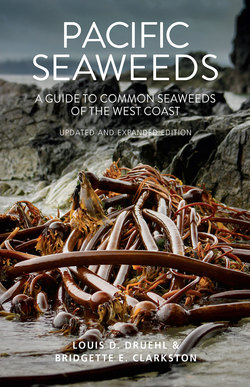Читать книгу Pacific Seaweeds - Louis Druehl - Страница 16
На сайте Литреса книга снята с продажи.
ОглавлениеPacific Seaweeds
16
a mature community from virgin substrate)? These and related questions are discussed in Identifying Pacific Seaweeds (p. 33) and Seaweed Ecology (p. 237).
Along with form comes an equally bewildering array of traits. Kyle Demes (Hakai Institute), whose PhD thesis explored seaweed material properties, likens seaweeds to the superpowers of comicbook superheroes. Some species can “shape-shift” (individuals look drastically different when grown in different environments; e.g., Callophyllis, p. 132), some can turn to stone (coralline algae and other calcifying species, p. 76, 81), others can clone themselves (reproduce asexually), some have extreme extensibility (e.g., Nereocystis, p. 226) and many can “fly” in the water using gas-filled floats (e.g., Macrocystis, p. 232).
Seaweeds and the Tree of Life
Seaweeds have a fascinating relationship to each other and to other groups of life. First, seaweeds around the world are divided among three groups: the green, red and brown seaweeds. Each group has distinctive storage products, cell wall components and, most noticeably, pigmentation; hence their common and formal names: Chlorophyta (Greek=green), Rhodophyta (Greek=red) and Phaeophyceae (Greek=brown). Second, you’d be forgiven for assuming that all seaweeds are relatively closely related given that many green, red and brown species overlap in form and live side by side; however, the three groups are actually separated by many millions of years of evolution. On the family tree of all life, the ancestral lines leading to modern-day green seaweeds and land plants separated roughly 1.2 billion years ago, with more than 1.5 billion years since red and green seaweeds shared a common ancestor! Brown seaweeds are a much younger lineage and so different that they are not considered related to either red or green seaweeds, much as we consider a jellyfish (now called a “jelly”) and a finfish not to be related. Thus, and third, the term “seaweed” encompasses an artificial assemblage of organisms. This artificial assemblage becomes obvious if you look at a family tree of the major groups of life (excluding bacteria and archaea, Figure 4). Since red and green seaweeds share a common ancestry with plants and their relatives, and brown seaweeds do not, we will only refer to red and green seaweeds as “plants” throughout this book.
The features shared by seaweeds mostly define a larger artificial assemblage, the algae (singular: alga, adjective: algal). Seaweeds share the
